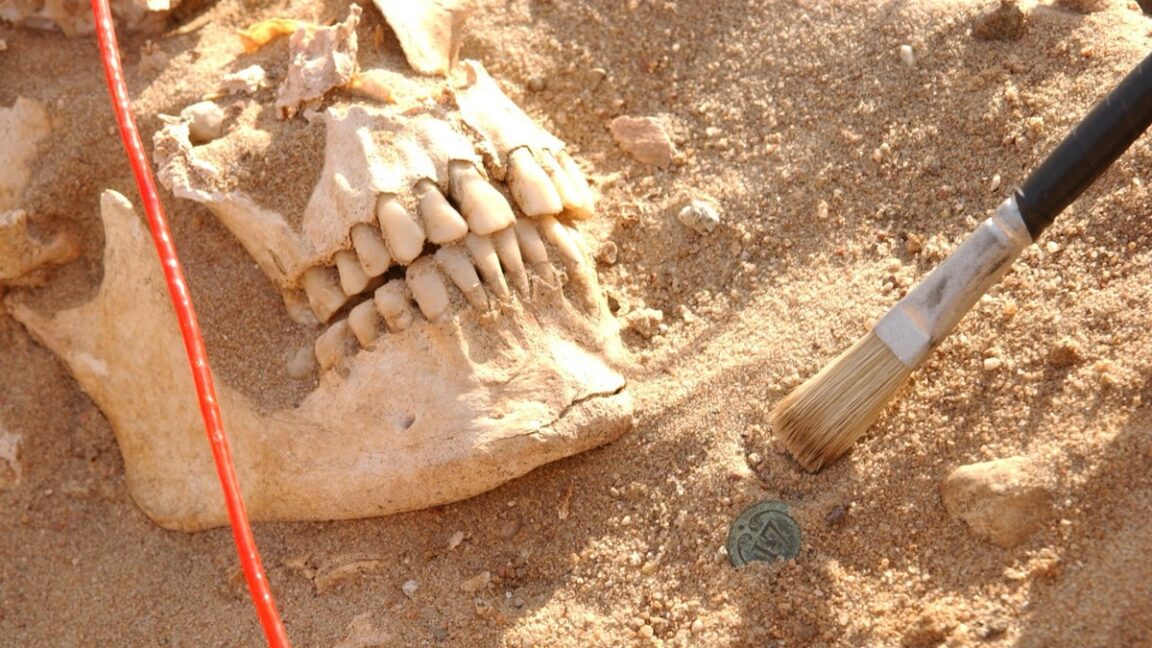Science
DNA Analysis Uncovers Pathogens Behind Napoleon’s Army Demise

Recent DNA analysis of remains from soldiers who perished during Napoleon Bonaparte‘s ill-fated 1812 campaign into Moscow has identified two pathogens likely responsible for significant fatalities. According to a study published in the journal Current Biology, these pathogens are Salmonella enterica, which causes paratyphoid fever, and Borrelia recurrentis, transmitted by body lice and responsible for relapsing fever. This research sheds new light on the health crises that afflicted Napoleon’s troops, revealing the deadly effects of disease alongside harsh environmental conditions.
The campaign, which began with approximately 615,000 soldiers, ended in catastrophe, with only about 110,000 returning. The vast majority of deaths—estimated at around 300,000—resulted not from combat but from the extreme cold, starvation, and rampant diseases during a notoriously brutal Russian winter. Scholars have long debated the specific illnesses that ravaged the French forces, and this latest analysis provides a more definitive insight.
“It’s very exciting to use a technology we have today to detect and diagnose something that was buried for 200 years,”
said Nicolás Rascovan, a co-author from Institut Pasteur. The ability to access the genomic data of historical pathogens enhances our understanding of how infectious diseases evolve and spread, offering lessons for contemporary public health challenges.
Historical accounts from Napoleon’s era, including medical reports, noted symptoms such as diarrhea, dysentery, fevers, and pneumonia, with typhus being particularly prevalent. Evidence supporting typhus has been previously gathered from mass graves, including a 2006 study that detected the pathogen R. prowazekii, though with inconclusive results. This was followed by a 2011 study that examined dental pulp samples, further complicating the understanding of diseases affecting the troops.
Rascovan and his colleagues critiqued earlier research methods, which relied on outdated PCR technologies for DNA analysis. Their study focused on remains from a mass grave in Vilnius, employing cutting-edge methodologies to yield more reliable results. In total, they examined 3,200 remains, focusing specifically on 13 teeth from different individuals to identify pathogens more accurately.
The researchers’ advanced techniques enabled them to detect S. enterica and B. recurrentis in four of the teeth. This finding provides the first direct genetic evidence of these infectious agents, which had previously received limited attention in discussions about the diseases that afflicted Napoleon’s army. Notably, there was no evidence of R. prowazekii or B. quintana, challenging the conclusions of the earlier studies.
While this research marks a significant advancement, the authors caution against drawing definitive conclusions from the limited sample size. They emphasize the need for further analysis to fully explore the potential presence of other diseases such as typhus and trench fever among the soldiers. Rascovan and his colleagues propose that a combination of fatigue, extreme cold, and multiple diseases—including paratyphoid fever and louse-borne relapsing fever—likely contributed to the catastrophic loss of life.
Paleogeneticist Sally Wasef from Queensland University of Technology commented that the findings, while intriguing, are more suggestive than conclusive due to the low quantities of microbial DNA recovered. Nonetheless, she recognizes the potential of such research to clarify the roles of disease in historical population declines, especially where written records may be incomplete or biased.
This groundbreaking study not only enriches our understanding of the challenges faced by Napoleon’s troops but also highlights the evolving capabilities of modern scientific methodologies in uncovering historical truths. The implications of this research extend beyond the battlefield, offering valuable insights into the dynamics of infectious diseases that continue to impact societies today.
-

 Education3 months ago
Education3 months agoBrandon University’s Failed $5 Million Project Sparks Oversight Review
-

 Science4 months ago
Science4 months agoMicrosoft Confirms U.S. Law Overrules Canadian Data Sovereignty
-

 Lifestyle3 months ago
Lifestyle3 months agoWinnipeg Celebrates Culinary Creativity During Le Burger Week 2025
-

 Health4 months ago
Health4 months agoMontreal’s Groupe Marcelle Leads Canadian Cosmetic Industry Growth
-

 Science4 months ago
Science4 months agoTech Innovator Amandipp Singh Transforms Hiring for Disabled
-

 Technology4 months ago
Technology4 months agoDragon Ball: Sparking! Zero Launching on Switch and Switch 2 This November
-

 Education4 months ago
Education4 months agoRed River College Launches New Programs to Address Industry Needs
-

 Technology4 months ago
Technology4 months agoGoogle Pixel 10 Pro Fold Specs Unveiled Ahead of Launch
-

 Business3 months ago
Business3 months agoRocket Lab Reports Strong Q2 2025 Revenue Growth and Future Plans
-

 Technology2 months ago
Technology2 months agoDiscord Faces Serious Security Breach Affecting Millions
-

 Education4 months ago
Education4 months agoAlberta Teachers’ Strike: Potential Impacts on Students and Families
-

 Science4 months ago
Science4 months agoChina’s Wukong Spacesuit Sets New Standard for AI in Space
-

 Education3 months ago
Education3 months agoNew SĆIȺNEW̱ SṮEȽIṮḴEȽ Elementary Opens in Langford for 2025/2026 Year
-

 Technology4 months ago
Technology4 months agoWorld of Warcraft Players Buzz Over 19-Quest Bee Challenge
-

 Business4 months ago
Business4 months agoNew Estimates Reveal ChatGPT-5 Energy Use Could Soar
-

 Business4 months ago
Business4 months agoDawson City Residents Rally Around Buy Canadian Movement
-

 Business4 months ago
Business4 months agoBNA Brewing to Open New Bowling Alley in Downtown Penticton
-

 Technology2 months ago
Technology2 months agoHuawei MatePad 12X Redefines Tablet Experience for Professionals
-

 Technology4 months ago
Technology4 months agoFuture Entertainment Launches DDoD with Gameplay Trailer Showcase
-

 Technology4 months ago
Technology4 months agoGlobal Launch of Ragnarok M: Classic Set for September 3, 2025
-

 Technology4 months ago
Technology4 months agoInnovative 140W GaN Travel Adapter Combines Power and Convenience
-

 Top Stories3 months ago
Top Stories3 months agoBlue Jays Shift José Berríos to Bullpen Ahead of Playoffs
-

 Science4 months ago
Science4 months agoXi Labs Innovates with New AI Operating System Set for 2025 Launch
-

 Technology4 months ago
Technology4 months agoNew IDR01 Smart Ring Offers Advanced Sports Tracking for $169










